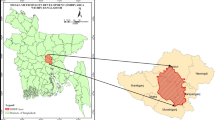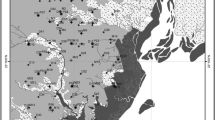Abstract
The detrimental effects of an earthquake are strongly influenced by the response of soils subjected to dynamic loading. The behavior of soils under dynamic loading is governed by the dynamic soil properties such as shear wave velocity, damping characteristics and shear modulus. Worldwide, it is a common practice to obtain shear wave velocity (V s in m/s) using the correlation with field standard penetration test (SPT) N values in the absence of sophisticated dynamic field test data. In this paper, a similar but modified advanced approach has been proposed for a major metro city of eastern India, i.e., Kolkata city (latitudes 22°20′N–23°00′N and longitudes 88°04′E–88°33′E), to obtain shear wave velocity profile and soil site classification using regression and sensitivity analyses. Extensive geotechnical borehole data from 434 boreholes located across 75 sites in the city area of 185 km2 and laboratory test data providing information on the thickness of subsoil strata, SPT N values, consistency indices and percentage of fines are collected and analyzed thoroughly. A correlation between shear wave velocity (V s) and SPT N value for various soil profiles of Kolkata city has been established by using power model of nonlinear regression analysis and compared with existing correlations for other Indian cities. The present correlations, having regression coefficients (R 2) in excess of 0.96, indicated good prediction capability. Sensitivity analysis predicts that significant influence of soil type exists in determining V s values, for example, typical silty sand shows 30.4 % increase in magnitude of V s as compared to silt of Kolkata city. Moreover, the soil site classification shows Class D and Class E category of soil that exists typically in Kolkata city as per NEHRP (Recommended provisions for seismic regulations for new buildings and other structures—Part 1: Provisions. Prepared by the Building Seismic Safety Council for the Federal Emergency Management Agency (Report FEMA 450), Washington, DC, 2003) guidelines and thereby highlighting the seismic vulnerability of the city. The results presented in this study can be utilized for seismic microzonation, ground response analysis and hazard assessment for Kolkata city.












Similar content being viewed by others
References
Akin MK, Kramer SL, Topal T (2011) Empirical correlations of shear wave velocity (Vs) and penetration resistance (SPT-N) for different soils in an earthquake-prone area (Erbaa-Turkey). Eng Geol 119:1–17
Arc GIS Version 10.0 ESRI (2011) ArcGIS desktop: release 10. Environmental Systems Research Institute, Redlands
Athanasopoulos GA (1995) Empirical correlations V so –N SPT for soils of Greece: a comparative study of reliability. In: Proceedings of 7th international conference on soil dynamics and earthquake engineering. Computation Mechanics Publications, Southampton, Boston, pp 19–25
Boominathan A, Dodagoudar GR, Suganthi A, Uma Maheswari R (2006) Seismic hazard assessment considering local site effects for microzonation studies of Chennai city. A workshop on microzonation, Interline Publishing, Bangalore, India, pp 94–104
Dikmen U (2009) Statistical correlations of shear wave velocity and penetration resistance for soils. J Geophys Eng 6:61–72
Govindaraju L, Bhattacharya S (2012) Site-specific earthquake response study for hazard assessment in Kolkata city, India. Nat Hazards 61:943–965
Haldar A, Mahadevan S (2000) Probability, reliability and statistical methods in engineering design. Wiley, New York
Hanumanthrao C, Ramana GV (2008) Dynamic soil properties for microzonation of Delhi, India. J Earth Syst Sci 117(S2):719–730
Hasancebi N, Ulusay R (2007) Empirical correlations between shear wave velocity and penetration resistance for ground shaking assessments. Bull Eng Geol Environ 66:203–213
Imai T (1977) P- and S-wave velocities of the ground in Japan. In: Proceedings of the IX international conference on soil mechanics and foundation engineering 2:127–132
Imai T, Yoshimura Y (1970) Elastic wave velocity and soil properties in soft soil (in Japanese). Tsuchito-Kiso 18(1):17–22
IS 1893: Part 1 (2002) Criteria for earthquake resistant design of structures—Part 1: General provisions and buildings. Bureau of Indian Standards, New Delhi
Iyisan R (1996) Correlations between shear wave velocity and in situ penetration test results (in Turkish). Chamb Civ Eng Turk Teknik Dergi 7(2):1187–1199
Jafari MK, Asghari A, Rahmani I (1997) Empirical correlation between shear wave velocity (Vs) and SPT-N value for south Tehran soils. In: Proceedings of the 4th international conference on civil engineering. Tehran, Iran
Jafari MK, Shafiee A, Razmkhah A (2002) Dynamic properties of fine grained soils in south of Tehran. Soil Dyn Earthq Eng 4:25–35
Japan Road Association (JRA) (1980) Specification and interpretation of bridge design for highway—Part V: Resilient Design, pp 14–15
Jinan Z (1987) Correlation between seismic wave velocity and the number of blow of SPT and depth. Selected papers from the Chinese Journal of Geotechnical Engineering ASCE, pp 92–100
Kalteziotis N, Sabatakakis N, Vassiliou J (1992) Evaluation of dynamic characteristics of Greek soil formations. In: Proceedings of 2nd Hellenic conference on geotechnical engineering 2:239–246 (in Greek)
Kiku H, Yoshida N, Yasuda S, Irisawa T, Nakazawa H, Shimizu Y, Ansal A, Erkan A (2001) In situ penetration tests and soil profiling in Adapazari, Turkey. In: Proceedings of the ICSMGE/TC4 satellite conference on lessons learned from recent strong earthquakes, pp 259–265
Lee SHH (1990) Regression models of shear wave velocities. J Chin Inst Eng 13:519–532
Lee SHH (1992) Analysis of the multicollinearity of regression equations of shear wave velocities. Soils Found 32(1):205–214
Maheshwari RU, Boominathan A, Dodagoudar GR (2010) Use of surface waves in statistical correlations of shear wave velocity and penetration resistance of Chennai soils. Geotech Geol Eng 28:119–137
Mhaske SY, Choudhury D (2010) GIS-based soil liquefaction susceptibility map of Mumbai city for earthquake events. J Appl Geophys 70(3):216–225
Mhaske SY, Choudhury D (2011) Geospatial contour mapping of shear wave velocity for Mumbai city. Nat Hazards 59:317–327
NEHRP (National Earthquake Hazards Reduction Program) (2003) Recommended provisions for seismic regulations for new buildings and other structures—Part 1: Provisions. Prepared by the Building Seismic Safety Council for the Federal Emergency Management Agency (Report FEMA 450), Washington, DC
Ohsaki Y, Iwasaki R (1973) On dynamic shear moduli and Poisson’s ratio of soil deposits. Soils Found 13(4):61–73
Ohta Y, Goto N (1978) Empirical shear wave velocity equations in terms of characteristics soil indexes. Earthq Eng Struct Dyn 6:167–187
Phanikanth VS, Choudhury D, Reddy GR (2011) Equivalent-linear seismic ground response analysis of some typical sites in Mumbai. Geotech Geol Eng 29(6):1109–1126
Pitilakis KD, Anastasiadis A, Raptakis D (1992) Field and laboratory determination of dynamic properties of natural soil deposits. In: Proceedings of the 10th world conference on earthquake engineering, Rotherdam, pp 1275–1280
Rollins KM, Evans MD, Diehl NB, Daily WD (1998) Shear modulus and damping relationships for gravels. J Geotech Geoenviron Eng ASCE 124:396–405
Seed HB, Idriss IM (1981) Evaluation of liquefaction potential sand deposits based on observation of performance in previous earthquakes. Preprint 81–544, in situ testing to evaluate liquefaction susceptibility, ASCE National Convention, Missouri, pp 81–544
Shiuly A, Narayan JP (2012) Deterministic seismic microzonation of Kolkata city. Nat Hazards 60:223–240
Shukla J, Choudhury D (2012a) Seismic hazard and site-specific ground motion for typical ports of Gujarat. Nat Hazards 60(2):541–565
Shukla J, Choudhury D (2012b) Estimation of seismic ground motions using deterministic approach for major cities of Gujarat. Nat Hazards Earth Syst Sci 12:2019–2037
Sitharam TG, Anbazhagan P (2007) Seismic hazard analysis for the Bangalore region. Nat Hazards 40:261–278
Sitharam TG, Anbazhagan P (2008) Site characterization using geotechnical and geophysical techniques for seismic microzonation of urban areas. In: Proceedings of international geotechnical conference on development of urban areas and geotechnical engineering, Saint Petersburg, Russia I:131–147
Ulugergerli EU, Uyanik O (2007) Statistical correlations between seismic wave velocities and SPT blow counts and the relative density of soils. J Test Eval 35(2):1–5
Youd TL, Idriss IM, Andrus RD, Arango I, Castro G, Christian JT, Dobry R, Liam Finn WD, Harder LF Jr, Hynes ME, Ishihara K, Koester JP, Liao SSC, Marcuson WF III, Martin GR, Mitchell JK, Moriwaki Y, Power MS, Robertson PK, Seed RB, Stokoe KH II (2001) Liquefaction resistance of soils. Summary report from 1996 NCEER and 1998 NCEER/NSF workshops on evaluation of liquefaction resistance of soil. J Geotech Geoenviron Eng ASCE 127:817–833
Acknowledgments
The authors gratefully acknowledge Prof. K. K. Chattopadhyay, Professor, Department of Civil Engineering, Bengal Engineering and Science University, Shibpur, India, for his fruitful suggestions and help to obtain authentic soil data of Kolkata region from various government and private organizations and are also thankful to the anonymous reviewers for their valuable and constructive comments.
Author information
Authors and Affiliations
Corresponding author
Rights and permissions
About this article
Cite this article
Chatterjee, K., Choudhury, D. Variations in shear wave velocity and soil site class in Kolkata city using regression and sensitivity analysis. Nat Hazards 69, 2057–2082 (2013). https://doi.org/10.1007/s11069-013-0795-7
Received:
Accepted:
Published:
Issue Date:
DOI: https://doi.org/10.1007/s11069-013-0795-7




